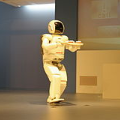Recent works in robotic manipulation through reinforcement learning (RL) or imitation learning (IL) have shown potential for tackling a range of tasks e.g., opening a drawer or a cupboard. However, these techniques generalize poorly to unseen objects. We conjecture that this is due to the high-dimensional action space for joint control. In this paper, we take an alternative approach and separate the task of learning 'what to do' from 'how to do it' i.e., whole-body control. We pose the RL problem as one of determining the skill dynamics for a disembodied virtual manipulator interacting with articulated objects. The whole-body robotic kinematic control is optimized to execute the high-dimensional joint motion to reach the goals in the workspace. It does so by solving a quadratic programming (QP) model with robotic singularity and kinematic constraints. Our experiments on manipulating complex articulated objects show that the proposed approach is more generalizable to unseen objects with large intra-class variations, outperforming previous approaches. The evaluation results indicate that our approach generates more compliant robotic motion and outperforms the pure RL and IL baselines in task success rates.
翻译:通过强化学习(RL)或仿造学习(IL),最近机器人操控的工程显示有潜力处理一系列任务,例如打开抽屉或橱柜。然而,这些技术对看不见的天体没有很好的概括性。我们推测这是高维行动空间共同控制的结果。在本文中,我们采取另一种办法,将学习“做什么”的任务与“如何做”的任务区分开来,即全体控制。我们提出RL问题,作为确定一个与显眼对象进行蒸发式虚拟操纵机互动的技术动态的一个问题。整个机体机器人运动运动控制最优化,以便执行高维联合运动,达到工作空间的目标。我们这样做的方法是解决具有机器人单一性和运动性限制的四边程序(QP)模型。我们在操纵复杂表达的物体方面的实验表明,拟议的方法比较笼统地适用于具有较大内部变异的看不见物体,超过了以往的方法。评价结果表明,我们的方法产生更符合要求的机器人运动,并超越了任务成功率的纯RL和IL基线。</s>




